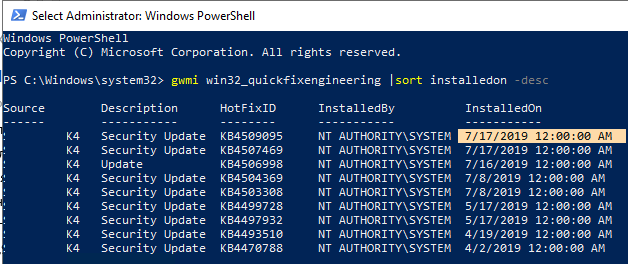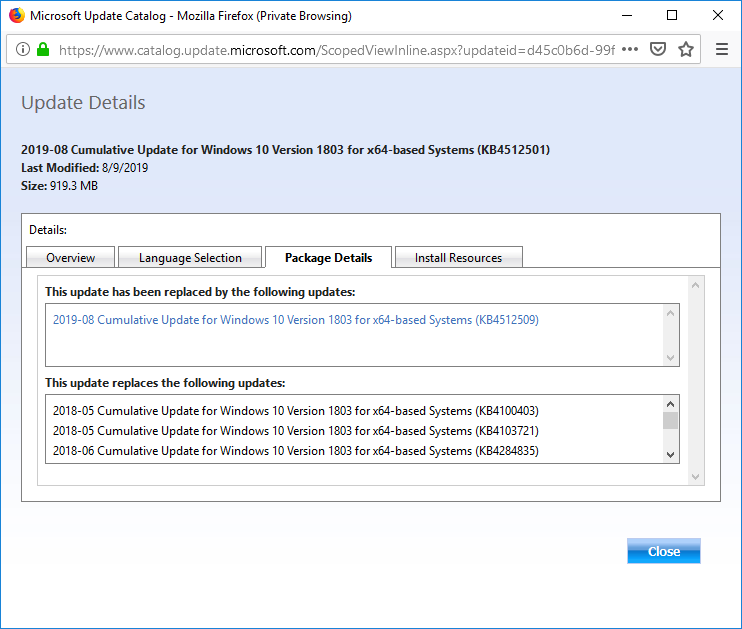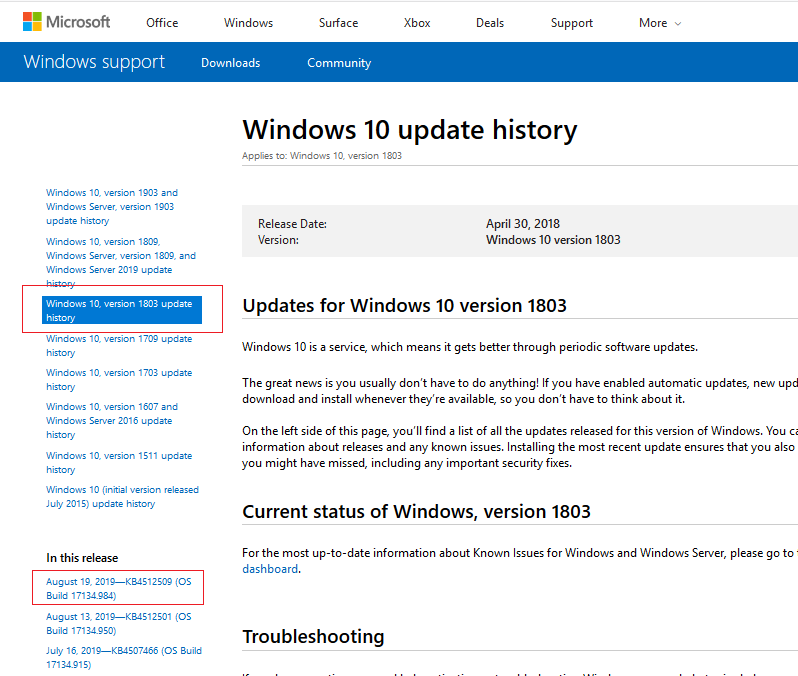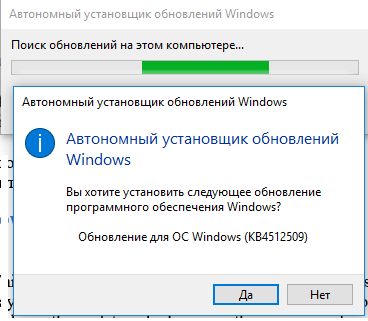- Как вручную скачать и установить обновления Windows 10?
- Определение даты установки последних обновлений и версии Windows
- Как найти и скачать последние обновления безопасности для вашей версии Windows 10?
- Как установить кумулятивное обновление Windows 10?
- Windows Update MiniTool для Windows
- Отзывы о программе Windows Update MiniTool
- How to download Windows Updates manually in Windows 10
- Download Windows Updates manually
- 4 Tools to Update Windows Offline and install Hotfixes from a Local Source
Как вручную скачать и установить обновления Windows 10?
Если вы противник установки обновлений Windows в автоматическом режиме, а служба Windows Update у вас находится перманенто в состоянии “Отключена”, то для обеспечения безопасности вашего компьютера вы должны каждый месяц вручную скачивать и устанавливать обновления Windows вручную. Также о ручной установке обновлений Windows (ну хотя бы иногда) задумываются и администраторы компьютеров в изолированных от интернета сегментах сети, при тестировании обновлений (если у вас не используется WSUS сервер, где можно вручную управлять тестированием и одобрением обновлений Windows) и ряде других случаев. В этой статье мы покажем, как вручную найти, скачать и установить актуальное кумулятивное обновление безопасности для вашей редакции Windows 10.
Определение даты установки последних обновлений и версии Windows
Вы можете проверить дату последних обновлений на компьютере с помощью следующей PowerShell команды:
gwmi win32_quickfixengineering |sort installedon -desc
На этом скриншоте видно, что последний раз на этом компьютере обновление безопасности устанавливалось 17 июня 2019 года.
Get-WUHistory|Where-Object <$_.Title -match "KB*">|Sort-Object date -desc
Теперь нам нужно узнать текущую версию и билд Windows. Воспользуйтесь командой:
Get-ComputerInfo | select WindowsProductName, WindowsVersion, OsHardwareAbstractionLayer, OsArchitecture
В моем случае мне нужно искать последние обновления безопасности для Windows 10 1803 x64.
Как найти и скачать последние обновления безопасности для вашей версии Windows 10?
Вы можете вручную скачать последние обновления для продуктов Microsoft из каталога обновлений Microsoft Update Catalog — https://www.catalog.update.microsoft.com/Home.aspx. В каталоге вы можете найти практически любое обновление для всех поддерживаемых версий Windows (также поддерживается прямой импорт обновлений через консоль WSUS). Главная проблема, что в каталоге отсутствует удобная система поиска, и, если вы не знаете номер KB, который вам нужно установить, найти и скачать пакет с обновлением довольно трудно.
Рассмотрим, как сформировать правильный запрос для поиска обновлений для вашей редакции Windows в каталоге обновлений Microsoft. Статья пишется 10 сентября 2019 года, соответственно последние обновления безопасности выпускались месяц назад, в августе. В нашем случае для поиска обновлений безопасности для Windows 10 1803 x64 за август 2019 года, воспользуйтесь таким поисковым запросом, который нужно вставить в поисковую строку в верхнем правом углу:
windows 10 1803 x64 8/%/2019
Каталог Microsoft Update вернул список из 6 обновлений.
Как решить какие из этих обновлений нужно скачать и установить? Конечно можно установить вручную все эти обновления, но можно и сэкономить время. Т.к. Microsoft перешла на кумулятивные обновлений, вам достаточно скачать и установить последнее Cumulative Update для вашей системы.
В нашем списке есть два больших ( по 900+ Мб) кумулятивных обновлений для Windows 10:
- 2019-08 Cumulative Update for Windows 10 Version 1803 for x64-based Systems (KB4512509) Windows 10 Updates 8/19/2019 — 930.7 MB
- 2019-08 Cumulative Update for Windows 10 Version 1803 for x64-based Systems (KB4512501) Windows 10 Security Updates 8/9/2019 — 919.3 MB
Щелкните по названию обновления безопасности KB4512501. В открывшемся окне с информацией об обновлении перейдите на вкладку Package Details. На этой вкладке видно какие обновления заменяет данное обновление (This update replaces the following updates:), и каким обновлением заменяется в свою очередь оно (This update has been replaced by the following updates). На скриншоте видно, что обновление KB4512501 заменяется KB4512509.
Теперь откроем свойства обновления KB4512509. Как вы видите, оно ничем не заменяется: This update has been replaced by the following updates: n/a. Значит это самое последнее и актуальное кумулятивное обновление для вашей редакции Windows 10.
Нажмите на кнопку Download, в открывшемся окне появится прямая ссылка на загрузку MSU файла обновлений. Скачайте файл и сохраните его на диск.
В списке слева выберите вашу версию Windows 10 (в моем примере это Windows 10 1803), затем обратите внимание на список In this release. Самая первая запись ссылается на статью базы знаний для последнего кумулятивного обновления Windows для выбранной редакции. В нашем примере это August 19, 2019—KB4512509 (OS Build 17134.984). Именно это обновление мы и скачали согласно первой методике.
Как установить кумулятивное обновление Windows 10?
После того, как вы скачали MSU файл с актуальным кумулятивным обновлением для вашей редакции Windows 10, вы можете его установить.
Для этого дважды щелкните по скачанному msu файлу и следуйте шагам мастера автономного установщика обновлений Windwows.
После окончания установки пакета обновлений нужно перезагрузить компьютер (если после установки обновления вы наблюдаете проблемы с работой ОС или приложений, вы можете удалить его).
Windows Update MiniTool для Windows
| Оценка: |
4.24 /5 голосов — 30 |
| Лицензия: | Бесплатная |
| Версия: | 20.12.2016 | Сообщить о новой версии |
| Обновлено: | 13.03.2017 |
| ОС: | Windows 10, 8.1, 8, 7, Vista, XP |
| Интерфейс: | Английский, Русский |
| Разработчик: | Stupid User |
| Категория: | Обновления, патчи |
| Загрузок (сегодня/всего): | 29 / 35 182 | Статистика |
| Размер: | 2,33 Мб |
| СКАЧАТЬ | |
Windows Update MiniTool — альтернатива стандартному Windows Update. Ищет обновления для вашей системы, затем вы выбираете необходимые и скачиваете для последующей установки.
Не требует установки.
- Проверка обновлений
- Скачивание обновлений (в папку \Windows\SoftwareDistribution\Download\)
- Установка обновлений
- Удаление установленных обновлений
- Скрытие нежелательных обновлений
- Получение прямых ссылок на *.cab/*.exe/*.psf/*.esd файлы обновлений
- Просмотр истории обновлений
- Настройка автоматических обновлений:
- Автоматически — Установка обновлений происходит в автоматическом режиме. Либо используются настройки конфигурации на панели управления Центра обновления Windows
- Отключено — Обновления не проверяются, не скачиваются, не устанавливаются
- Режим уведомлений — Уведомлять перед загрузкой и установкой любых обновлений
- Только скачивать — Автоматически загружать обновления и уведомлять об их готовности к установке
- По расписанию — Автоматически загружать обновления и устанавливать их по указанному расписанию
- Управляется администратором — Этот вариант позволяет локальным администраторам выбирать режим конфигурации на панели управления Центра обновления Windows
- Режим Offline (необходим файл wsusscn2.cab, который нужно поместить в папку с программой)
Внимание! Первая проверка обновлений может длиться до двух часов. Чтобы ускорить поиск нужно установить обновление KB3138612.
Win Updates Disabler — бесплатный и простой в использовании инструмент для управления.
Media Creation Tool — бесплатный инструмент от компании Microsoft с помощью которого можно легко.
Microsoft Windows XP Service Pack 3 — официальный пакет обновления 3 (SP3) для Windows XP содержит все ранее.
Windows Update MiniTool — альтернатива стандартному Windows Update. С ее помощью вы в любой момент сможете.
ASUS BIOS Live Update — Фирменная утилита для обновления BIOS материнских плат ASUS через интернет.
Show or hide updates — специальная утилита от Microsoft для ручного отключения установки выбранных патчей для новейшей операционной системы Windows 10.
Отзывы о программе Windows Update MiniTool

Отзывов о программе Windows Update MiniTool 20.12.2016 пока нет, можете добавить.
How to download Windows Updates manually in Windows 10
Most of us use Windows Update or Microsoft Update to keep our Windows 10/8/7 operating system and Microsoft software updated. But if you want to, for some, reason, download the updates manually and save it to your computer, this is how you can go about it:
Download Windows Updates manually
On Windows 10, open Settings > Update & Security > Windows Update. Here you can Check for updates.
If any Update has failed to install, you will see it mentioned this.
Note down the KB number of the Windows Update.
On Windows 7, 0pen your Control Panel and navigate to the Windows Update applet. If updates are available, click on the Important updates are available, or the Optional updates are available link. You will be able to see the list along with the KB numbers.
If no updates are available, click on Review your update history link. Here you will see the complete list of Windows Updates including Security Updates and Service Packs, if any, which have been installed on your computer.
Note down the KB number mentioned in the bracket.
Now that you have the KB number, and search for it here on Microsoft.com. If you find no suitable results for Downloads, select All Microsoft. In the results, you will see the Knowledge Base article about the update or hotfix and also the Download page.
If you open its KB article page, you will see the download links for all operating system. Select your operating system and click on the link to be taken to its download page.
Click on the download button to download and save the Windows Update to your computer.
This way, you will be able to install the update manually on any one or more of your computers, as long as it applies to the installed operating system or software.
Downloading, saving, and installing Windows Update manually may be done if you need to save the updates for some reason or if you find that you are unable to update your Windows using Windows Update.
- Microsoft Update Catalog is a service from Microsoft that provides a listing of software updates that can be distributed over a corporate network. Using the Microsoft Update Catalog can prove to be a one-stop location for finding Microsoft software updates, drivers, and hotfixes.
- WSUS Offline Update is a free tool using which, you can update Microsoft Windows or Microsoft Office easily without having an Internet connection.
- Portable Update lets you update Windows 10 offline without an Internet connection.
Date: December 24, 2020 Tags: Windows Updates
4 Tools to Update Windows Offline and install Hotfixes from a Local Source
How often do you install a clean version of a Windows operating system either for yourself or somebody else? Although a lot of users are sensible and make full backups of their system using either disk imaging software or something like the Windows 7 System image function, there is sometimes no option but to reinstall because it can’t be avoided. Hardware failures, viruses, or even computers with poor performing or highly abused operating systems are all reasons to have to wipe the old system and start again. Some users even install their operating system regularly to keep it clean and running at maximum performance.
Whether you’re installing a new Windows by choice or by necessity, you will soon be pretty sick of wasting hours downloading all the hotfixes from Windows Update and continuously downloading patch after patch. Having just installed Windows 7 to see how many updates are available for the most popular version of Windows, it’s quite shocking to see it has 117 important updates ready to be downloaded! And that obviously doesn’t include recommended updates like the multitude of newer .NET Framework patches and subsequent updates after you install software like Internet Explorer 9 or 10 etc.
One solution is to use a slipstreaming application like nLite to integrate hotfixes into the install disc, but even these become outdated every month after the latest round of hotfixes. If waiting for all the updates to install doesn’t appeal, an alternative is to have a program store and automatically install the updates for you from a USB stick or external hard drive. While it isn’t as quick as a slipstreamed disc, this method is an awful lot quicker than waiting for everything to be downloaded and installed from the internet, and can be left to it while you go and do something else. Here are 4 applications that can do exactly that, you can even run them on a currently installed Windows to bring it up to date.
AutoPatcher has been around for several years and used to be distributed as a huge executable file that included all the update patches inside. After complaints from Microsoft in 2007, it was modified to download and distribute the patches direct from Microsoft’s own servers. AutoPatcher isn’t just a tool to apply Windows hotfixes though. Besides being able to install critical and recommended Windows updates, it can also do the same for Microsoft Office and install a number of extras such as the Office add-on pack, Adobe Flash and Reader, JAVA, the .NET Framework and Visual C++ patches.
The package itself is split into 2 modules, the updater module (apup.exe) is where you select and download the chosen update packages, and the Patcher module (Autopatcher.exe) which you run to select the updates and addons to install on the unpatched system. Make sure to select and download the latest AutoPatcher program, engine and common module updates as the patch installer module gets downloaded in the engine update.
Tick everything you want and click Next to start downloading. When all the required updates are downloaded, simply take the whole folder on a flash drive or hard drive to the target computer, or find the network drive, and run AutoPatcher.exe. After a few EULA screens and a file integrity check, the options screen will be displayed where the available updates and extras can be chosen for install. Critical or important patches will be ticked already, those in blue are currently installed on your system and don’t need selecting unless there is a specific need to do so.
Click the button and then wait for AutoPatcher to install all the updates you have selected. To use AutoPatcher all you need on your operating system is the latest service pack to be able to install hotfix updates as it doesn’t support older Service Pack installs. SP3 for XP, SP2 for Vista and SP1 for Windows 7. Windows 8 isn’t supported yet although there is talk in their forum of implementing it in the future. You don’t need a clean install either, even the latest up to date Windows can still install any other add ons or extras that aren’t currently installed. This is an essential tool to save serious amounts of time and effort.
2. WSUS Offline Update
Formally called c’t Update, WSUS Offline Update is another tool that can update a number of Windows operating systems to the latest patches, and also keep nearly all versions of Microsoft Office up to date too. Although like Autopatcher in a lot of ways, there’s also some differences. WSUS Offline Update can update any Windows revision and doesn’t rely on it having the latest Service Pack installed. This can be a great help as lots of computers still don’t have XP Service Pack 3 or Vista Service Pack 2 installed which makes Autopatcher unusable until they’re updated. It can also download and install updates for several different languages so you’re not restricted to just English.
After downloading, extracting and running the UpdateGenerator.exe, tick the boxes to select the operating system versions, Office versions and languages you require. Everything is split over 3 tabs called Windows, Office and Legacy products which includes Windows XP and Office 2003 as support for them ends in 2014. Some of the Options are very useful such as whether to download Service Packs, and whether to include Microsoft Security Essentials or Defender definitions in the package. The inclusion of C++ Runtimes and .NET Frameworks is also optional but leaving them included will be a BIG time saver.
Something else WSUS Offline Update can do is write the update package to an ISO image which can be burned to CD/DVD/Blu-ray. Great for older systems or if you don’t have the right sized USB flash drive handy. Alternatively choose the USB medium option to copy the updates onto a USB flash or hard drive. Once you press Start, a Command Prompt window will open and begin downloading the files from Microsoft, the wait could be long if you’ve selected multiple options.
















